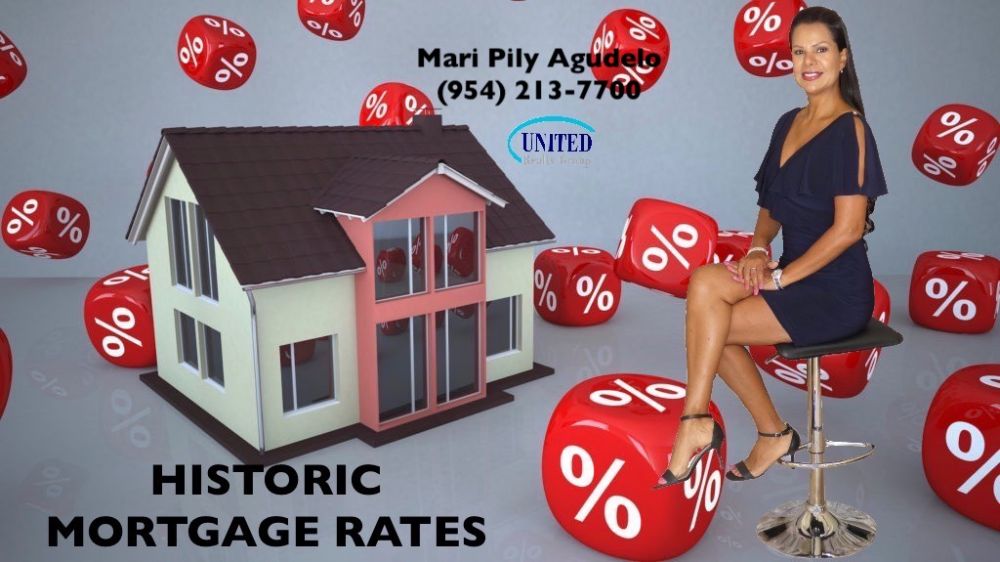
Mortgage Rates Plummet to 13th Record Low of 2020
As the economy still struggles with the ongoing effects of COVID-19, mortgage
rates dropped to a new record low for the thirteenth time this year.
For the week ending November 19, the average rate for a 30-year fixed-rate mortgage
was 2.72% with 0.7 discount points paid, according to Freddie Mac’s weekly Primary Mortgage Market Survey.
That’s a 0.12 percentage point drop from last week’s rate of 2.84% and 0.06 percentage
points below the previous record low of 2.78% set two weeks ago.
A year ago, the rate on 30-year fixed-rate mortgages averaged 3.66%.
The decline occurred even after more positive news concerning a COVID-19 vaccine was made pulic.
“Weaker consumer spending data, which accounts for the majority of economic growth, drove mortgage
rates to a new record low,” said Sam Khater, chief economist for Freddie Mac.
“While economic growth remains unstable, strong housing demand continues to have a domino effect
on many other segments of the economy.”
The average rate for a 15-year fixed-rate mortgage increased by 0.06 percentage points to 2.28% with
0.6 points paid. The 15-year interest rate for the same week last year was 3.15%.
The average rate on a 5-year adjustable-rate mortgage saw a significant drop to 2.85% with 0.3 discount
points paid, plunging 0.26 percentage points from last week.
Meanwhile, the Department of Labor reported Thursday that initial jobless claims totaled 742,000 for the
week ending November 14. The claims were higher than economists’ expectations of 710,000 and
represent an increase of 31,000 claims from last week’s revised total. The four-week moving average
was 742,000, a decrease from the previous week’s revised average of 755,750.
Continuing claims, tracking those who have received unemployment benefits for two straight weeks or more,
totaled 6,372,000 for the week ending November 7. (The continuing claims data is delayed by one week.)
Continuing claims decreased by 429,000 from the previous week’s revised level.
The seasonally adjusted insured unemployment rate, which calculates the number of people receiving
unemployment benefits versus the total labor force, decreased by 0.3 percentage points to 4.3%.
While new unemployment claims have been steadily declining in the last few months, there are still a
massive number of people out of work as a result of the pandemic. The total number of people claiming
benefits in all unemployment programs totaled 20,319,615 for the week ending October 31, down 841,245
from the previous week. By comparison, there were 1,476,521 people claiming benefits from all programs
during the same week last year.
Home Buying Bounces Back
Overall, the number of mortgage loan applications ticked down by 0.3% for the week ending November 13,
according to data from the Mortgage Bankers Association, thanks in large part to a drop in refinance loans.
Home purchase applications, however, increased by 4% from the previous week. Overall, purchase applications
were 26% higher than the same week a year ago.
Mortgage Interest Rate Forecasts
On Thursday, the yield on the 10-year Treasury note opened at 0.855%, down 0.025 percentage points from
Wednesday’s close of 0.88%. Yields, which had come close to the 1% on November 10, have been trending
down the last couple of weeks. Yields originally dropped after the minutes from the Fed’s last meeting were
released expressing concerns about the economic recovery. Before March, the note’s yield had never dipped
below 1%, even during the Great Recession. The 10-year Treasury is a key benchmark for mortgage rates.
Treasury yields have held at low levels since the Federal Reserve indicated that it expects to keep the short-term
Federal Funds rate at its current range of 0% to 0.25% through 2022 or longer, as part of its economic policy now
includes keeping rates low long enough for inflation to rise above the central bank’s goal of 2%.
Factors Affecting Your Personal Mortgage Rate
Not all shoppers can expect to get the very best mortgage and refinance rates. Credit scores, loan term,
interest rate types (fixed or adjustable), down payment percentage, home location, and the loan’s size will
affect mortgage rates offered to individual home shoppers.
Rates also vary between mortgage lenders. It’s estimated that about half of all buyers only look at one lender,
primarily because they tend to trust referrals from their realtors. Yet this means that they may miss out on a
lower rate elsewhere. Last year, Freddie Mac reported that buyers who got offers from five different lenders
averaged 0.17 percentage points lower on their interest rate than those who didn’t get multiple quotes.
If you want to find the best rate and term for your loan, it makes sense to shop around first.
Interest Rates and Your Monthly Payment
More than other factors, your annual percentage rate on your real estate purchase will affect your monthly
payments—whether you’re refinancing or buying a new home.
On a $200,000 home loan with a fixed rate for 30 years:
- At 3% interest rate = $843 in monthly payments (not including taxes, insurance, or HOA fees).
- At 4% interest rate = $955 in monthly payments (not including taxes, insurance, or HOA fees).
- At 6% interest rate = $1,199 in monthly payments (not including taxes, insurance, or HOA fees).
- At 8% interest rate = $1,468 in monthly payments (not including taxes, insurance, or HOA fees).
Refinancing to a lower interest rate could save hundreds of dollars a month if you kept the same loan terms.
Shortening the loan term could negate your monthly savings but save thousands over the life of the loan.
You can experiment with a mortgage calculator to find out how much a lower rate could save you.
Other factors besides interest affect how much you’ll pay in mortgage payments:
- Private Mortgage Insurance: PMI adds up to 1% of your home loan’s value to your payment each year.
- On a $200,000 mortgage loan, PMI at 1% would add $167 a month to your payment.
- Conventional loans do not require private mortgage insurance when the buyer makes a down payment
- of at least 20% or refinances less than 80% of the home’s value. FHA loans do not require PMI, but do
- require what is called a Mortgage Insurance Premium, which is paid throughout the life of the loan if you
- make a down payment of less than 10%. VA loans do not require PMI, MIP, or a down payment.
- Closing Costs: Some buyers finance their new home’s closing costs into the loan, which adds to debt
- and increases monthly payments.
- Loan Term: Choosing a 15-year mortgage instead of a 30-year mortgage will increase monthly mortgage
- payments but reduce the amount of interest paid throughout the life of the loan.
- Fixed vs. ARM: An adjustable rate mortgage’s monthly payment could change from year to year after the
- loan’s introductory period expires. A fixed rate loan’s payments remain the same throughout the life of the loan.
- Taxes, HOA Fees, Insurance: A monthly mortgage payment could also include homeowners insurance
- premiums, city or county property taxes, and Homeowners Association fees. Check with your real estate agent
- to find out how much they would add to your payments.
What Type of Mortgage Loan Do You Need?
First-time homebuyers can walk into a mortgage brokerage office or visit an online lender without knowing what kind
of mortgage they need. But it’s always better to have an idea of what you’re shopping for, especially since you
can’t control other factors such as home prices and current rates.
Mortgage loan options include:
- Conventional Borrowing: Shoppers with higher credit scores and higher down payments can get a conventional
- mortgage with either a fixed or adjustable rate. Mortgage interest rates can be low for qualified buyers.
- Subsidized Borrowing: The Federal Housing Administration and the U.S. Department of Agriculture help first-time
- homebuyers and shoppers in low-income areas buy homes by subsidizing their mortgage loans. FHA and USDA
- loans allow shoppers with lower credit profiles (a FICO score of 580) to still get affordable home financing.
- Subsidized loan restrictions include borrowing maximums and safe housing inspections.
- These loans are for single-family homes in most cases.
- Veterans Affairs Loans: Veterans and active-duty service members can buy homes with no down payment and
- no PMI through the Department of Veterans Affairs’ lending program. Banks make loans that are guaranteed by the VA.
- VA loans require a funding fee which could range from 1.4% to 3.64% for first-time homebuyers.
- Repeat VA borrowers or refinances require lower fees. Even with the fee, these loans can save veterans thousands of dollars a year.
- Jumbo Loans: Homes in high-value housing markets like San Francisco and New York City may not fit within a conventional or FHA loan.
Will Today’s Mortgage Rates Save You Money on a Refinance?
You should consider refinancing your home loan if your current mortgage rate exceeds today’s mortgage rates
by more than one percentage point. Refinancing fees and closing costs would cut into your savings.
You also have to consider whether your credit score would qualify you for today’s best refinance rates.
How to Find the Best Mortgage Lender
Homebuyers have dozens of choices for lenders. Your local bank or credit union probably writes mortgage
loans with rates close to the current national average. A loan officer in your local branch could guide you through the process.
Online lenders have expanded their market share over the past decade. You could get pre-approved within minutes.
Your loan amount combined with current mortgage rates could define your price range for homes prices in your area.
Many online lenders also assign a dedicated loan officer to offer continuity as you shop.
Shop around to compare rates and terms, and make sure your lender has the loan option you need.
Should You Buy Discount Points to Lower Mortgage Rates?
Many lenders sell discount points. Buying discount points means you’d pay more up front to lower your mortgage
rate which could save you money long-term. A mortgage discount point normally costs 1% of your loan amount
and could shave 0.25% off your interest rate.
With a $200,000 mortgage loan, a point would cost $2,000. Buying two points would cost $4,000 which would be due,
in cash, when you close the loan. These two discount points would translate into a 0.5% reduction to your interest rate.
Discount points could pay off but only if you keep the home loan long enough. Selling the home or refinancing the
mortgage within a couple years would short circuit the discount point strategy. But if you stayed in the loan indefinitely,
you’d reach a break-even point after which the discount points would save you more and more over time.
Often, spending cash on a down payment instead of discount points saves more unless you know for sure you’re
keeping the loan for years. If a larger down payment could help you avoid paying PMI premiums,
put the money toward your down payment instead of discount points.
Looking to Sell or Buy a home?
CALL ME
MARI PILY AGUDELO
(954) 213-7700





